Shouldn’t be too hard to decide what that is! Horror stories abound – and it must be one of the few plants ever legislated about. Yet it all started out innocuously enough on a beautiful country estate in Mid-Wales in the 1880s. I’m referring, of course, to that chance cross between the Nootka cypress and the Monterrey cypress which currently rejoices in the botanical name of x Cupressocyparis leylandii although it’s better known as just Leylandii.
Read on to discover the amazing Welsh estate where it all started, why it almost didn’t happen, and then how the monster was encouraged in the name of horticulture!
The story of the Leylandii begins in 1847 with a rather impressive wedding present. When wealthy Liverpool banker John Naylor got married, his even wealthier uncle, Christopher Leyland, gave him a house. Not just any old house, of course, but the Leighton Hall estate near Welshpool in Montgomeryshire, which centred on a Tudor house set in a deer park.
Naylor immediately began a process of modernization. He rebuilt the house in the romantic Gothic style, installed steam-powered central heating, built an estate gasworks, and a six-story observation tower, at a reputed cost of £275,000, and then spent an additional £200,000 on a huge industrial scale Victorian farm that used pioneering technology. The house interiors were designed Pugin and carried out by the Craces, and Naylor commissioned Edward Kemp to landscape the grounds.
Edward Kemp had trained under Paxton at Chatsworth in the 1830s and in 1843 was asked by Paxton to charge of Birkenhead Park, where he remained as superintendent for 40 years.This did not stop him working elsewhere and in 1850, writing a successful ‘textbook’ : How to lay out a garden: intended as a general guide in choosing, forming, or improving an estate … with reference to both design and execution which ran through several editions. Gardener’s Chronicle called it ‘the best book on pure garden design in the English language’, (19 June 1858, p.496).
Kemp laid out formal gardens around the new house in a style that he referred to as ‘architectural gardening’ in his book. Most of these have now vanished, although the basic layout survives. He also designed pleasure grounds complete with evergreen shrubberies with winding walks and ornamented with summerhouses, a decorative water cascade, and a newly fashionable camellia house. There was also a mini-menagerie with bison and kangaroo roaming parts of the estate. When you see the house at the foot of the hill you can see why he also installed a small funicular railway!
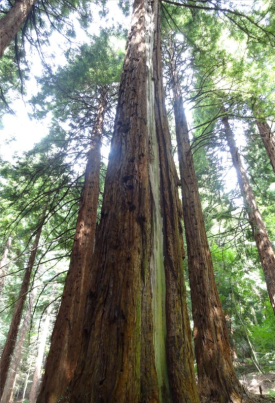
Coastal redwood from the original [planting, from http://rfs.org.uk/media/53032/leighton-information-sheet.pdf
Both Naylor and Kemp also followed the fashionable craze for conifers which had been sweeping Victorian Britain since David Douglas and William Lobb, amongst others, starting introducing new species from the west coast of north America. A grove of coastal redwoods was planted in about 1857, and is now the largest and oldest in Europe, with some trees exceeding 40m. It was extended into a pinetum over the succeeding decades with specimen pines, firs, monkey puzzles, spruce, hemlock and cedars. Together they now form an arboretum that is Grade 1 listed and managed by the Royal Forestry Society.

The pinetum at Leighton Hall
from http://rfs.org.uk/media/53032/leighton-information-sheet.pdf
It was at Leighton Hall that John Naylor’s son, Christopher, was born in 1849. After a career in the Navy he returned to Leighton Hill and worked on improving the estate, particularly its forestry.
In 1888,in the pinetum nursery he noted amongst a batch of Nootka cypress seedlings, six with unusual characteristics. These are now thought to have occurred from their accidental cross-pollination from a Monterey cypress that had been planted nearby. In the wild these trees have habitats hundreds of miles apart, but must be closely related. Since then there have about 20 reported natural hybridization between the two species, always by open pollination, whilst attempts to hybridized artificially have failed.
Rather than discard the oddities, the six seedlings were separated out from the rest of the standard seedlings which were destined for the plantation. They allowed to grow on and they flourished…
Two years later in 1891 Christopher inherited Haggerston Castle in Northumberland from his great uncle. Changing his name to Leyland in memory of his benefactor, he decided to move there, giving Leighton Hall to his nephew Christopher John Naylor.
By 1893 Leyland had largely rebuilt the main house on a grand scale including an observatory, rotunda, ballroom and concert hall There was electricity and coal-fired central heating too.

Christopher Leyland
http://www.twmuseums.org.uk
He also designed a large Italian garden and oversaw the landscaping of the 23,000 acres estate. [See The Garden, December 2005). Unfortunately we do not have an entry on our database for Haggerston so if anyone knows much more about it please get in touch.
But Leyland did not leave everything behind at Leighton Hall….and guess what? Amongst the things he took from Wales to Northumberland were the six seedlings… now not quite so small.
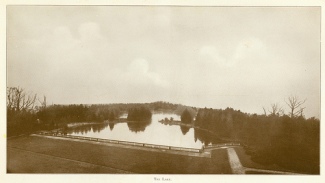
The Lake at Haggerston from the 1930 auction particulars for the estate
http://rectoversoblog.com
They were planted out at Haggerston and to his surprise, they not only tolerated the cold salt-laden winds from the North Sea but they grew at the rate of about a metre a year, evidently combining the rapid growth of the Monterey cypress with the hardiness of the Nootka cypress. He took cuttings and planted them around the estate, calling them Leyland cypress but did nothing else much to publicise his unusual trees.
It was not until 1925 after a visit by arboriculturalists to see some other ‘new’ trees at Leighton Hall that news got out. These ‘new’ trees were the result of a similar natural cross between the Nootka and Monterey pines which ha dbeen ‘discovered’ and then planted out in 1911 by Christopher John Naylor.
According to Alan Mitchell [The Garden, November 1979] in 1916 cuttings were sent to Bicton and Inverary Castle and probably Headfort. They all grew extremely fast. Mitchell reports them as all being 30m and above.
In 1925 foliage from these crosses was sent to Kew, and botanists Bruce Jackson and William Dallimore formally described the new hybrids as Cupressus x leylandii in the Kew Bulletin in March 1926, which also told the story of both sets of seedlings.

Kew herbarium sheet for the lectotype Cupressocyparis leylandii, “Haggerston’
http://apps.kew.org/herbcat/getImage.do?imageBarcode=K001090493

Plate from Jackson & Dallimore’s article in Kew Bulletin, 1926, presumably of either a tree at Leighton Hall, or more likely, Haggerston Castle
It would appear that Dallimore and Jackson also went to Haggerston to see the six transplants – one of which was now 35ft – and obtained material from the trees not just for formal botanical description but also for propagation. It was from their cuttings that the first trees at at Kew, Wisley [1925], Bedgebury Pinetum in Kent [1929], and the Royal Botanic Garden in Edinburgh were grown. Hilliers were sending out plants commercially from 1930.
Wales has a rival for the fame of being the birthplace of the leylandii. There is a claim from Northern Ireland that the first cross between Nootka and Monterey was not at Leighton Hall but about 10 years earlier at Rostrevor, in County Down. This was not officially recorded, but Alan Mitchell discovered that the original cross seedling (of unknown origin) was given to the gardener at Rostrevor who planted it in the garden there.Although the original tree blew down around 1914 cuttings had been propagated from it. Mitchell estimated from the size of the tree and that the original hybrid cross must have occurred around 1870 (‘Clones of Leyland Cypress’. International Dendrology Society Yearbook 1985, pp 97-100). The RHS Plantsman also recently agreed that the Rostrevor clone was probably older than the Leighton Hall crosses.[see https://www.rhs.org.uk/about-the-rhs/publications/magazines/The-Plantsman/2011-issues/december/The-fertility-of-Leyland-cypress]

Cupressocyparis Leylandii ‘Green’
from http://www.englishhedging.com/?p=85
Leyland cypress soon entered commercial production because of their ability to cope with difficult conditions and provide shelter quicker and more effectively than most other species. But as a hybrid, it was generally assumed their seeds would be sterile, and that they therefore had to be propagated vegetatively from cuttings. Recently James Armitage of the RHS has conducted experiments that seems to show that in fact Leylandii can [horror of horrors] in fact set fertile seed, although they are self-sterile and require a nearby compatible pollen donor, backing up some earlier evidence of this from New Zealand. [The Plantsman, December 2011].
Because sports also develop naturally, there are now over forty forms of Leyland cypress in cultivation. Most derive from the six seedlings taken to Haggerston, including the vast majority of the green hedging Leylandii in the UK which are either ‘Hagerstown Grey’ or ‘Leighton Green’. The golden form ‘Castlewellan’, originates from a single tree raised in 1962 from seed from cones of the golden form of the Monterey which stood near the golden form of the Nootka cypress, in the Castlewellan Forest Park in County Down. The fullest account of of the various clones and varieties can be found in “The Clones of Leyland Cypress” by Ovens, Blight & Mitchell, in Quarterly Journal of Forestry (1964 v.58(1): 8-19.)
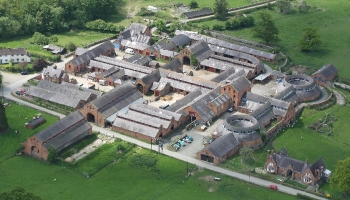
The model farm buildings at Leighton Hall is now home to Yorton Farm Stud
http://www.yortonfarm.co.uk
And what of its places of origin? Leighton Hall is still there, although merely a ghost of its former self. The original farming estate was fragmented in the early 20thc, and apart from a short spell as a private school, the house has remained unused almost ever since. Luckily it is Grade 1 listed. After featuring in a SAVE report in 1995, although its future was touch and go for a while, it and the amazing farm buildings are now in the hands of committed people who want to restore and use them again. For more information see the photographs on wikipedia: http://en.wikipedia.org/wiki/Leighton_Hall,_Powys
and read the story on the local village website:

Illustrated Particulars of Sale with Plans and Conditions of Sale of the Valuable Freehold Sporting, Manorial, Residential Estate, known as Haggerston Castle,
http://rectoversoblog.com/2009/12/18/in-consequence-of-the-demolition-of-haggerston-castle/
Haggerston suffered a worse fate. Christopher Naylor/Leyland died just after his tree was ‘discovered’ by the outside world in 1926.
By 1930 his son was desperate to get rid of the estate and the 150 roomed castle and its contents, including the gardener’s stock of plants were put up for sale. No buyer was forthcoming so the contents and fittings down to the gardeners stock of plants were auctioned off in 3500 lots and the castle largely demolished. If you want to know more then look at :

leylandii can make a decent hedge if it is manintained properly from http://www.maryharehistory.org.uk/photos/reunion2006/028_manor_fishpond_E_b.jpg
The tower and the rotunda remain standing and form the centrepieces to a caravan and holiday park. In July 2006 there were reports that the Italian walled garden which had survived hidden behind a large black gate were going to be restored, but I’ve not been able to find out much more. I did however discover some film footage from 2010 which shows how much further there is to go…although the potential for something truly spectacular is clearly there!
http://www.youtube.com/watch?v=2tbnr8eDdGw
For many years the Leyland cypress was the biggest-selling item in every garden centre in Great Britain, making up to 10% of total sales. It has also been exported to virtually every country in the world with varying degrees of success. Of course what buyers tended to forget is that although their new hedge grows rapidly and soon creates the privacy and shelter they require, it does not then politely stop growing. Instead it demands requires very regular trimming to keep it in check.

Hedge drama: Ex-regimental sergeant major Eric Harper (pictured) has taken his neighbours to court over their 15ft-high Leylandii conifers in Wolverhampton
Daily Mail, 19th May 2009
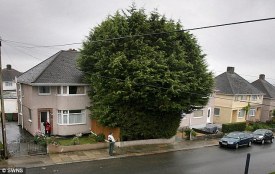
The man with a forest in his garden: Fed-up residents demand action over neighbour’s 35ft leylandii cypress trees
Daily Mail, 8th Sept 2010
If that is done it’s a very effective hedge and can be maintained at almost height BUT If that isn’t done, equally quickly, it become a scourge of many neighbourhoods by growing too tall and causing boundary disputes. Since the tallest specimen is now 130ft high and still growing rapidly there are probably going to be a lot more problems to come!
Read more about such disputes at:

Final cut: Christine Wright, of Norfolk, won a 24-year battle against these trees
Daily Mail 8th Sept 2010
Meanwhile commercial nurseries are trying, through careful selection, to create a new generation of Leyland cypress seedlings, supposedly better suited to small gardens!


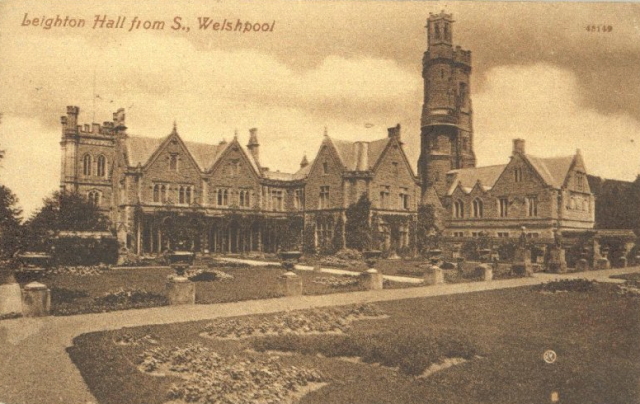

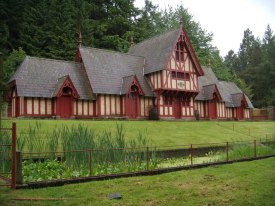

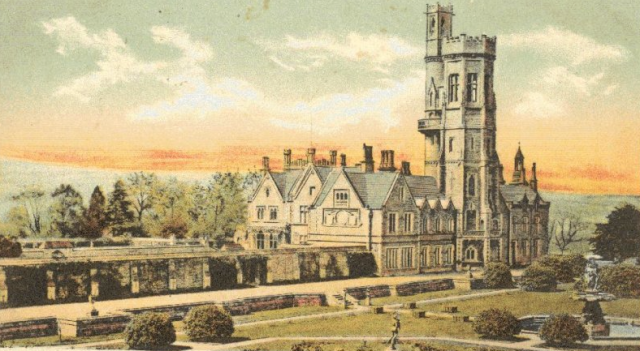





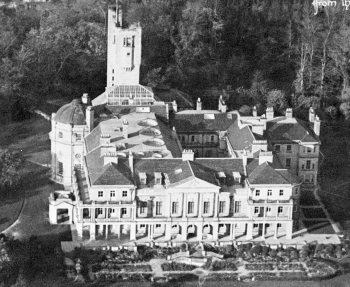



Pingback: Article about Leighton’s most famous export - Leighton Village
LEYLAND CYPRESS – MEA CULPA When I was a student at RBG Kew in the mid-1950s there was an impressive hedge of Leyland Cypress (the first ever?) in the arboretum nursery planted, I think, by Sidney Pearce, Assistant Curator and still in charge at the time. It was part of a trial / demonstration of hedging plants. Trimmed twice a year the dreaded Leyland performed impeccably and seemed the perfect hedging plant – fast growing, hardy, evergreen, wind-firm and easy enough to propagate from cuttings. I left Kew in 1958 and lived for a few months in West Kensington, but I must admit now to having “borrowed” thirty or so cuttings of Leyland Cypress, as a Kew memento, which I rooted in a window box. These travelled with us to Essex when I was appointed assistant lecturer at Writtle College. We eventually planted them in the garden of our new bungalow. As part of my course of lectures to Diploma students I waxed enthusiastic about the merits of Leyland Cypress and announced proudly that my hedge ( by 1960) was already 2m high. As a result one student from a fruit-growing family, took a great interest, having in mind starting out in commercial nursery stock production. By then Leyland Cypress were being talked about increasingly as the perfect hedging plant, planted out from the newly popular plastic pots. As a result I was able to sell (at a very reasonable price!) hundreds of cuttings of Leyland Cypress as the nucleus of an emerging enterprise. Who would have dreamt then of the impact of Leyland Cypress on the urban and rural landscape of Britain, as successive hedges were planted and inevitably neglected? Worse still has been the devastating spectacle of the yellow one, especially in Northern Ireland. Now both green and gold are widely infected with Phytopthora which makes matters even worse! And yet, used imaginatively as a specimen or group, Leyland Cypress can be a handsome or dramatic feature on the big scale. John Sales